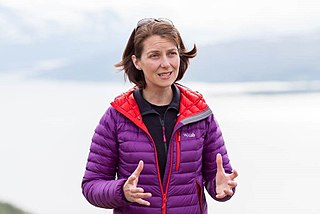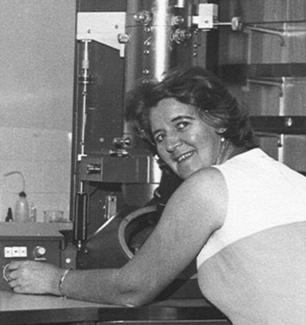Related Research Articles

The volcanic winter of 536 was the most severe and protracted episode of climatic cooling in the Northern Hemisphere in the last 2,000 years. The volcanic winter was caused by at least three simultaneous eruptions of uncertain origin, with several possible locations proposed in various continents. Most contemporary accounts of the volcanic winter are from authors in Constantinople, the capital of the Eastern Roman Empire, although the impact of the cooler temperatures extended beyond Europe. Modern scholarship has determined that in early AD 536, an eruption ejected massive amounts of sulfate aerosols into the atmosphere, which reduced the solar radiation reaching the Earth's surface and cooled the atmosphere for several years. In March 536, Constantinople began experiencing darkened skies and lower temperatures.

Eldgjá is a volcano and a canyon in Iceland. Eldgjá is part of the Katla volcano; it is a segment of a 40 kilometres (25 mi) long chain of volcanic craters and fissure vents that extends northeast away from Katla volcano almost to the Vatnajökull ice cap. This fissure experienced a major eruption around 939 CE, which was the largest effusive eruption in recent history. It covered about 780 square kilometres (300 sq mi) of land with 18.6 cubic kilometres (4.5 cu mi) of lava from two major lava flows.

John Templeton (1766–1825) was a pioneering Irish naturalist, sometimes referred to as the "Father of Irish Botany". He was a leading figure in Belfast's late eighteenth-century enlightenment, initially supported the United Irishmen, and figured prominently in the town's scientific and literary societies.

Tephrochronology is a geochronological technique that uses discrete layers of tephra—volcanic ash from a single eruption—to create a chronological framework in which paleoenvironmental or archaeological records can be placed. Such an established event provides a "tephra horizon". The premise of the technique is that each volcanic event produces ash with a unique chemical "fingerprint" that allows the deposit to be identified across the area affected by fallout. Thus, once the volcanic event has been independently dated, the tephra horizon will act as time marker. It is a variant of the basic geological technique of stratigraphy.

Mount Churchill is a dormant volcano in the Saint Elias Mountains and the Wrangell Volcanic Field (WVF) of eastern Alaska. Churchill and its neighbor Mount Bona are both ice-covered volcanoes with Churchill having a 2.7-by-4.2-kilometre-wide caldera just east of its summit. There are sparse outcrops of lava flows and tephra, mostly dacite.
Folan, is an Irish family name. They were a Brehon family in County Galway. The Folan family are of Conmhaícne origin.
The Hekla 3 eruption (H-3) c. 1000 BC is considered the most severe eruption of Hekla during the Holocene. It threw about 7.3 km3 of volcanic rock into the atmosphere, placing its Volcanic Explosivity Index (VEI) at 5. This would have caused a volcanic winter, cooling temperatures in the Northern Hemisphere for several years afterwards.

Reclus, also written as Reclús, is a volcano located in the Southern Patagonian Ice Field, Chile. Part of the Austral Volcanic Zone of the Andes, its summit rises 1,000 metres (3,300 ft) above sea level and is capped by a crater about 1 kilometre (0.62 mi) wide. Close to the volcano lies the Amalia Glacier, which is actively eroding Reclus.
Gearóid Mac Eoin was an Irish academic whose studies focused especially on aspects of Irish language, literature and history.
Tham Lod Rockshelter, first researched by Rasmi Shoocongdej from Silpakorn University, funded by the Thai Research Fund, was a prehistoric cemetery and a workshop located in Northern Thailand known to have human inhabitants from the late Pleistocene to the late Holocene period Additionally, Tham Lod is near Ban Rai, another rock shelter and is in the vicinity of two well known caves, Spirit Cave and Tham Lot cave. Recent researches and carbon dating suggested that Homo sapiens have occupied the area. These researches provide more detail on the activities by the humans in the area which includes burials, living habits, gathering, and tool making, and social interactions.
Mary J. P. "Maura" Scannell (1924–2011) was a leading Irish botanist.

Elsa Guðbjörg Vilmundardóttir was the first Icelandic woman to complete a degree in geology and was the country's first female geologist. But she did much more outside of the field of geology, and was very involved in her community. She was a co-founder of the Icelandic Earth Association, being its chair for four years.

Herbert Edgar Wright Jr. was an American Quaternary scientist. He contributed to the understanding of landscape history and environmental changes over the past 100,000 years in many parts of the world. He studied arid-region geomorphology and landscape evolution, as well as glacial geology and climate history. His study of these topics led him to the study of vegetation development and environmental history and allowed him to define the timing and mechanisms of climate-driven vegetational shifts in North America during the last 18,000 years and to recognize the role of natural fire in the dynamics of northern coniferous forests. He applied these insights to wilderness conservation and landscape management. He covered many other aspects of paleoecology including lake development and paleolimnology, and the history and development of the vast patterned peatlands of Minnesota and elsewhere in the Northern Hemisphere. Although his work was concentrated in Minnesota, he was also involved in a major synthesis of global paleoclimatology. Beyond Minnesota and the Great Lakes region, Wright studied a wide range of research questions elsewhere in North America, and in the Near East, Europe, Asia, Latin America, and Antarctica. He advised over 75 graduate students and mentored many more students, visitors, and colleagues worldwide.

Jennifer McKinley is a scientist from Northern Ireland, UK. She is currently a Reader at the School of Natural and Built Environment, Queen's University Belfast. Her main areas of research interest include geostatistics, GIS, soil geochemistry, forensics geoscience, weathering. She is the elected president of International Association for Mathematical Geosciences for the period during 2016–2020. She was awarded Chartered Fellow of the Geological Society of London in 2009, a Fellowship awarded competitively.

Siwan Davies FLSW is a Welsh professor of Physical Geography in the department of science at Swansea University.

Johanna Alida Coetzee was a researcher in the field of Palynology at the University of the Free State and a pioneer in the analysis of fossil pollen. Her DSc thesis received worldwide recognition and praise from the eminent glacial geologist Richard Foster Flint and helped recognise the significance of temperature changes in controlling shifts in global and local vegetation zones.

Fleet Moss is an upland area separating Wharfedale from Wensleydale in North Yorkshire, England. The area is 1,850 ft (560 m) above sea level. Fleet Moss is noted for its peat blanket bog, which has been dated to the Neolithic period. The area is ombrotrophic; this means it needs rain, hail snow and fog for its nutrients. Fleet Moss is known as the most eroded blanket bog in all of Yorkshire; because of its observable damage, it is known colloquially as The Somme, and as such, is visible from space.

Harry John Betteley Birks is a botanist and emeritus professor at the University of Bergen and University College London. He is best known for his work on the development of quantitative techniques in Quaternary palaeoecology. He has researched the vegetational and environmental history over the past 10–20,000 years in many parts of the world, including Fennoscandia, UK, Minnesota, the Yukon, Siberia, and Tibet.

Vatnaöldur is the name of a series of craters in the Suðurland region of Iceland. They are located in the Highlands of Iceland, north–west of the Veiðivötn and north–east of Landmannalaugar, within the municipality of Rangárþing ytra. It is part of the Eastern volcanic zone (EVZ).
Meriel McClatchie is an archaeologist specialising in archaeobotany. She is an associate professor at University College Dublin.
References
- ↑ "Prof Valerie Hall". School of Geography, Archaeology and Palaeoecology. Queens University, Belfast. Retrieved 11 October 2014.
- ↑ "Network Member Profiles: Valerie Hall, Queen's University, Belfast". Irish Environmental History Network. Trinity College Dublin. Archived from the original on 4 March 2016. Retrieved 11 October 2014.